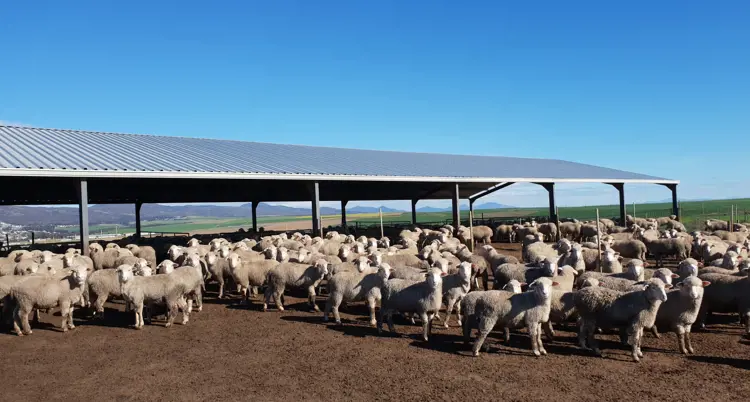
What factors influence the profitability of feedlots?
- The first factor will always be the price at which the lambs are bought. If you feed your lambs, it will be the store lamb price vs the slaughter price.
- Feed conversion ratio (FCR): the amount of feed intake (kg) to gain 1 kg of body weight
- Dressing percentage
- Average daily gain (ADG)
The impact of each factor on the profitability will also vary from year to year and is influenced by the ratio between the prices of meat, grain and feed. The higher the feed prices are about the meat price, the more important the FCR becomes. If the meat price is higher and the cost of feed lower, then the dressing percentage has a bigger impact on the feasibility of a feedlot. It is, therefore, important to know and apply these factors in the decision-making process.
For maximum profit in the feedlot, it is important to ensure a perfect start.
Three important factors to consider for an optimal start:
1. Good quality lamb:
- Healthy lambs between 27 and 30kg
- Age between 2 and 4 months (maximum)
- Lambs that were fed creep feed
- Respiratory diseases are the most common diseases in feedlots, and lambs should be vaccinated in advance.
Success in the feedlot always starts with a good-quality lamb. A healthy, young lamb has good growth potential and will have a much better FCR compared to an older lamb with a similar weight. Sick lambs should also not be fed in a feedlot.
2. Adaptation:
- The rumens of the lambs must be adapted to rations that contain high levels of starch
- Animals grow better when they are familiar with the type of rations used (pellets or meal)
Profits can be significantly lower if the adaptation process is not done correctly. Lambs that were fed creep feed will not only be heavier at a younger age but will also be adapted to a high starch diet already, reducing time spent on adaptation. Although adaptation is a necessity, it does not always make economic sense to put lambs on adaptation diets for 7 – 14 days if growth during this period is compromised.
There are various commercial products on the market that contain micro-organisms that deal with the problems associated with adaptation. Dosing these products before lambs go into the feedlot helps with the shortening of the adaptation period, and lambs can go directly onto the feedlot rations without adverse effects. This can save time and money because lambs grow to their maximum potential from day one. If, however, traditional adaptation is made where intake increases over time, enough feeding space must be provided in this period (20 – 30 cm per lamb), and sufficient quantities of good quality roughage should be supplied ad lib.
3. Grouping of lambs:
- Lambs should be grouped in weight classes of 3 - 5 kg
- There should ideally be 40 - 60 lambs in a pen
- Rams and ewes should be kept separately.
Competition between animals in feedlots often prevents younger and smaller lambs from achieving maximum intake, and this impacts growth negatively. Having smaller pens with fewer animals of similar weight per pen eliminates this problem and brings uniformity in a group, resulting in the pen being ready for slaughter at the same time. It is also recommended that once animals have been assigned to a pen, keep them in the same pen for the duration and not move them around at all.
Feed conversion rate and ration:
As lambs get older, their ability to convert feed to mutton decreases. For this reason, the best possible ration should be fed that yields the best FCR and optimise this period as far as possible. Next to the purchasing price of a lamb, feed cost is the second largest expense and is therefore important. Unfortunately, there seem to be some misconceptions that the cheapest feed yields the highest profits. That is not always the truth, and we should rather be guided by the FCR of a feed and determine the margin over feed cost from that to determine which is the most profitable ration to use. Cheaper rations often consist of inferior raw materials and need to be fed at higher quantities to yield the same growth as more expensive feed made from good quality raw materials. The best way to determine this is to do on-farm trials where the feed intake is measured against growth to determine the FCR and dressing percentage from different feed sources. The inclusion of growth promoters in the feed also plays a big role in terms of growth rate, feed conversion and profit.
General management guidelines:
- Always have cool, clean drinking water available (clean troughs daily)
- For optimum growth, provide animals with adequate shade – preferably not in front of the feeding troughs
- Feed lambs’ ad-lib. 3 – 4 times daily. This will stimulate feed intake, and feed will stay fresh
- Crossbred lambs perform better than purebred lambs
- Lambs should not be fed for longer than 45 - 55 days (depending on their weight when they enter the feedlot).
